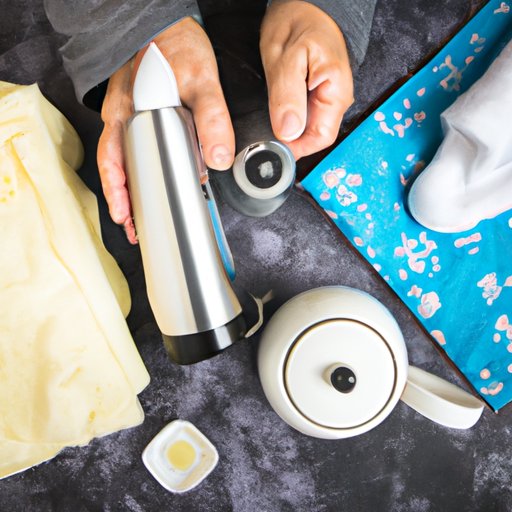
Introduction
As the temperature drops and winter sets in, it can be a challenge to stay warm and comfortable. Feeling cold can be uncomfortable and even unhealthy, particularly for those who have conditions like Raynaud’s disease or hypothermia. This article offers 7 tips to beat the cold and stay warm this winter.
Here are the 7 tips we will cover:
- Layer your clothing
- Consume hot drinks
- Exercise regularly
- Utilize a heating pad
- Stay hydrated
- Use a warm blanket
- Take warm showers
Layer Your Clothing
One of the best ways to stay warm is by layering your clothing. Layering works by trapping warm air between the layers, providing insulation for your body. Start with a thin layer of tight-fitting clothing next to your skin, followed by a thicker insulating layer, and then finish with a protective outer layer to keep the wind at bay.
When layering, it’s important to choose the right materials. Natural fibers like wool and silk are great insulators and wick away moisture, while synthetic materials like polyester and nylon are good for repelling moisture and keeping you dry.
Other tips for effective layering include:
- Adding or removing layers as necessary to maintain a comfortable body temperature
- Investing in quality, well-fitting clothing
- Paying special attention to extremities like hands, feet, and head by utilizing gloves, socks, and hats
Consume Hot Drinks
Warm beverages like tea, coffee, and hot cocoa can help to raise your internal body temperature and keep you feeling warm. In addition, the act of holding a hot mug can provide a comforting sensation in your hands and help to promote relaxation.
To maximize the warming effects of hot drinks, consider consuming them around mealtimes or at the beginning of your day. Avoid drinking caffeine late in the day, as it can interfere with sleep. Milk-based beverages or herbal teas like chamomile can be good options for those who want to avoid caffeine but still enjoy the warming effects of a hot drink.
Exercise Regularly
Regular exercise can be a great way to get your blood flowing and raise your internal body temperature. When exercising, your body produces heat as a byproduct of burning calories. This heat helps to keep you feeling warm even after your workout is over.
Effective exercises for warming up include:
- Yoga or stretching – movements that gently stretch your muscles and increase circulation
- Running or jogging – cardiovascular exercise that increases your heart rate and body temperature
- Strength training – builds muscle mass, which helps to increase your resting metabolic rate and, in turn, raise your body temperature
Remember to always warm up properly before exercising, as this can help to prevent injury and ensure that your body is properly prepared for physical activity.
Utilize a Heating Pad
A heating pad or electric blanket can be a great way to warm up quickly and conveniently. Heating pads work by applying direct heat to your skin, which helps to improve circulation and increase your body temperature.
When using a heating pad, follow these tips:
- Choose a heating pad that’s appropriate for your needs – for example, a pad with adjustable temperature settings or one that can be used for both moist and dry heat
- Apply the heating pad to areas where you feel cold – for example, your back, neck, or feet – and leave it on for 20-30 minutes at a time
- Be careful not to fall asleep while using a heating pad, as this can increase the risk of burns or injury
Stay Hydrated
Drinking enough water and other fluids is essential for maintaining a healthy body temperature. When you’re dehydrated, your body is less efficient at regulating temperature, which can leave you feeling cold and uncomfortable.
Good options for warm fluids include:
- Herbal teas or flavored water
- Bone broth or soup
- Warm milk or hot cocoa
In addition to drinking warm fluids, consider incorporating more hydrating foods into your diet. Foods with high water content like cucumber, celery, and watermelon can help to keep you hydrated.
Use a Warm Blanket
A cozy blanket can be a simple yet effective solution for staying warm. Choosing the right type of blanket is important – look for materials like wool or down that trap heat and provide insulation. Consider investing in an electric blanket for an extra-warm and convenient option.
Situations where a warm blanket can be particularly useful include:
- Watching TV or reading on the couch
- During long car rides or flights
- While sleeping at night
Take Warm Showers
Like hot drinks, warm showers can help to raise your body temperature and promote relaxation. Taking a shower before bed can help you to feel warmer and more relaxed, which can promote better sleep. However, be careful not to overdo it with the temperature – extremely hot water can actually have the opposite effect and leave you feeling cold.
Conclusion
Feeling cold doesn’t have to be a fact of life during the winter months. By layering your clothing, consuming warm drinks, exercising regularly, utilizing a heating pad, staying hydrated, using a warm blanket, and taking warm showers, you can stay warm and comfortable even in the coldest of temperatures.
Remember to always take care when trying new tips for staying warm, and to choose options that work best for your individual needs and preferences.





